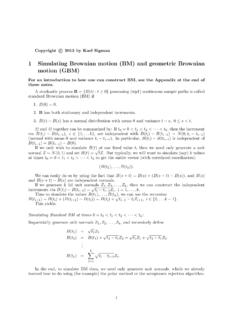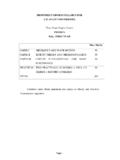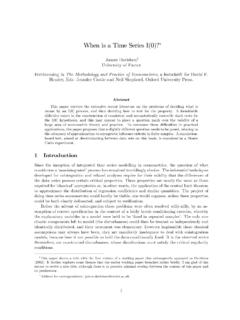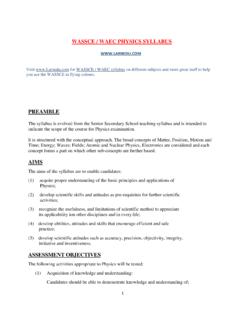Transcription of 1 Geometric Brownian motion - Columbia University
1 Copyrightc 2006 by Karl Sigman1 Geometric Brownian motionNote that since BM can take on negative values, using it directly for modeling stock prices isquestionable. There are other reasons too why BM is not appropriate for modeling stock , we introduce here a non-negative variation of BM calledgeometric Brownian motion ,S(t), which is defined byS(t) =S0eX(t),(1)whereX(t) = B(t) + tis BM with drift andS(0) =S0>0 is the intial value. Takinglogarithms yields back the BM;X(t) = ln(S(t)/S0) = ln(S(t)) ln(S0). ln(S(t)) = ln(S0)+X(t)is normal with mean t+ ln(S0), and variance 2t; thus, for eacht,S(t) has we will see in Section : lettingr= + 22,E(S(t)) =ertS0(2)the expected price grows like a fixed-income security with continuously compoundedinterest practice,r >> r, the real fixed-income interest rate, that is why one invests in stocks.
2 Butunlike a fixed-income investment, the stock price has variability due to the randomness of theunderlying Brownian motion and could drop in value causing you to lose money; there is riskinvolved Lognormal distributionsIfY N( , 2), thenX=eYis a non-negative having thelognormal distribution; calledso because its natural logarithmY= ln(X) yields a normal densityf(x) ={1x 2 e (ln(x) )22 2,ifx 0;0,ifx < is derived via computingddxF(x) forF(x) =P(X x) =P(Y ln(x)) = ((ln(x) )/ ),where (x) denotes the ofN(0,1).Observing thatE(X) =E(eY) andE(X2) =E(e2Y) are simply the moment generatingfunction (MGF)MY(s) =E(esY) ofY N( , 2) evaluated ats= 1 ands= 2 respectivelyyieldsE(X) =e + 22E(X2) =e2 +2 2V ar(X) =e2 + 2(e 2 1).}
3 As with the normal distribution, the (x) =P(X x) = ((ln(x) )/ ) does nothave a closed form, but it can be computed from the unit normal cdf (x). Thus computationsforF(x) are reduced to dealing with (x).1We denote a lognormal , byX lognorm( , 2). Back to our study of Geometric BM,S(t)=S(0)eX(t)For 0 =t0< t1< < tn=t, the ratiosLidef=S(ti)/S(ti 1),1 i n,are independentlognormal which reflects the fact that it is the percentage of changes of the stock pricethat are independent, not the actual changesS(ti) S(ti 1). For exampleL1def=S(t1)S(t0)=eX(t1),L2def=S(t 2)S(t1)=eX(t2) X(t1),are independent and lognormal due to the normal independent increments property of BM;X(t1) andX(t2) X(t1) are independent and normally distributed.
4 Note how therefore we canre-writeS(t) =S0L1L2 Ln,(3)an independent product ofnlognormal For example, suppose we wish to sample thestock prices at the end of each day. Then we could chooseti=iso thatLi=S(i)/S(i 1),the percentage change over one day, and then realize (3) as the independent product of suchdaily changes. In this case theLiare also identically distributed sinceti ti 1= 1 for eachi:ln(Li) is normal with mean and variance BM not only removes the negativity problem but can (in a limited and approxi-mate sense) be justified from basic economic principles as a reasonable model for stock pricesin an ideal non-arbitrage world. Roughly speaking, no one should be able to make a profitwith certainty, by observing the past values{S(u) : 0 u t}of the stock, and this forces usto consider non-negative models possessing this property.
5 The idea is to force a level playingfield , in which the evolution of the stock prices must be such that the activity of buying orselling stock offers no arbitrage Geometric BM is a Markov processJust as BM is a Markov process, so is Geometric BM:the future given the present state isindependent of the (t+h) (the future,htime units after timet) is independent of{S(u) : 0 u < t}(thepast before timet) givenS(t) (the present state now at timet). To see that this is so we notethatS(t+h) =S0eX(t+h)=S0eX(t)+X(t+h) X(t)=S0eX(t)eX(t+h) X(t)=S(t)eX(t+h) X(t).Thus givenS(t), the futureS(t+h) only depends on the future increment of the BM,X(t+h) X(t).
6 But BM has independent increments, so this future is independent of thepast; we get the Markov note that{X(t+h) X(t) :h 0}is yet again BM with the same drift and means that givenS(t), the future process{S(t)eX(t+h) X(t):h 0}defines (in distribu-tion) the same Geometric BM but with new initial valueS(t). (So the Markov process has timestationary transition probabilities.) Computing moments for Geometric BMRecall that the moment generating function of a normal N( , 2) is given byMX(s) =E(esX) =e s+ 2s22, < s < .Thus for BM with drift, sinceX(t) N( t, 2t),MX(t)(s) =E(esX(t)) =e ts+ 2ts22, < s < .This allows us to immediately compute the moments and variance of Geometric BM, byusing the valuess= 1,2 and so on.
7 For example,E(S(t)) =E(S0eX(t)) =S0MX(t)(1), andE(S2(t)) =E(S20e2X(t)) =S20MX(t)(2):E(S(t)) =S0e( + 22)t(4)E(S2(t)) =S20e2 t+2 2t(5)V ar(S(t)) =S20e2 t+ 2t(e 2t 1).(6)Similarly, any ratio,S(t)/S(s) =eX(t) X(s), s < t, being lognormal (sinceX(t) X(s) N( (t s), 2(t s))) has mean and varianceE{S(t)/S(s)}=e( + 22)(t s)(7)E{S2(t)/S2(s)}=e2 (t s)+2 2(t s)(8)V ar{S(t)/S(s)}=e2 (t s)+ 2(t s)(e 2(t s) 1).(9)Lettingr= + 22,we see thatE(S(t)) =ertS0,and more generallyE{S(t)/S(s)}=er(t s). The Binomial model as an approximation to Geometric BMThe binomial lattice model (BLM) that we used earlier is in fact an approximation to geometricBM, and we proceed here to explain the that for BLM,Sn=S0Y1Y2 Yn, n 0 where theYiare distributed asP(Y=u) =p, P(Y=d) = 1 p.
8 Besides the initial valueS0, the parameters 0< d <1+r < u,and 0< p <1 completely determine this model. Our objective here is to estimate what these3parameters should be in order for this BLM to nicely approximate Geometric BM over a giventime interval (0, t].From (3) we can quickly see that for any fixedtwe can re-writeS(t) as a similar prod-uct, by dividing the interval (0, t] intonequally sized subintervals (0, t/n], (t/n,2t/n], .. ,((n 1)t/n, t], definingti=it/n,0 i nand definingLi=S(ti)/S(ti 1). Each ln(Li) has a nor-mal distribution with mean t/nand variance 2t/n. Thus we can approximate Geometric BMover the fixed time interval (0, t] by the BLM if we appoximate the lognormalLiby the simpleYi.))))))
9 To do so we will just match the mean and variance so as to produce appropriate values foru, d, p:Findu, d, psuch thatE(Y) =E(L) andV ar(Y) =V ar(L). This is equivalent to matchingthe first two moments;E(Y) =E(L) andE(Y2) =E(L2).Noting thatE(Y) =pu+ (1 p)dandE(Y2) =pu2+ (1 p)d2, and (from Section )E(L) =e t/n+ 2t/2nandE(L2) =e2 t/n+2 2t/n, we must solve the following two equations foru, d, p:pu+ (1 p)d=e t/n+ 2t/2n(10)pu2+ (1 p)d2=e2 t/n+2 2t/n.(11)Since we have only two equations, there is no unique solution; we have one degree of freedomin the sense that we can apriori force one variable to take on a certain value (p= forexample), and then solve for the other two.
10 The most common relationship to force isud= 1,which says thatu= 1/d, and has the effect of making the stock price in the BLM have the niceproperty that an up followed by a down (or vice versa) leaves the price alone:udS0=duS0= shall assume , letting = + 2/2, we can re-write the equations asud= 1,(12)pu+ (1 p)d=e (t/n),(13)pu2+ (1 p)d2=e(2 + 2)(t/n).(14)(13) allows us to solve forpin terms ofuandd,p=e (t/n) du d.(15)Then using this formula forptogether withud= 1 to plug into the (14) allows us to solve foru(and henced) (see derivation below):u=12(e (t/n)+e( + 2)(t/n)) +12 (e (t/n)+e( + 2)(t/n))2 4(16)Whennis large, so thatt/nis small, the solution can be approximated by the more simpleu=e t/n,(17)d=e t/n.














